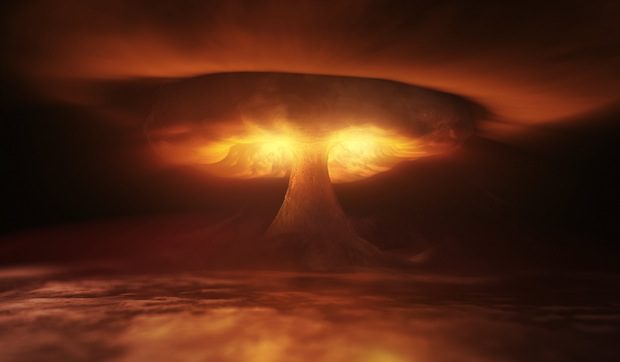The Guns of August 2015

Are you paying attention to this? I had not been. Max Fisher:
It was in August 2014 that the real danger began, and that we heard the first warnings of war. That month, unmarked Russian troops covertly invaded eastern Ukraine, where the separatist conflict had grown out of its control. The Russian air force began harassing the neighboring Baltic states of Estonia, Latvia, and Lithuania, which are members of NATO. The US pledged that it would uphold its commitment to defend those countries as if they were American soil, and later staged military exercises a few hundred yards from Russia’s border.
Both sides came to believe that the other had more drastic intentions. Moscow is convinced the West is bent on isolating, subjugating, or outright destroying Russia. One in three Russians now believe the US may invade. Western nations worry, with reason, that Russia could use the threat of war, or provoke an actual conflict, to fracture NATO and its commitment to defend Eastern Europe. This would break the status quo order that has peacefully unified Europe under Western leadership, and kept out Russian influence, for 25 years.
Fearing the worst of one another, the US and Russia have pledged to go to war, if necessary, to defend their interests in the Eastern European borderlands. They have positioned military forces and conducted chest-thumping exercises, hoping to scare one another down. Putin, warning repeatedly that he would use nuclear weapons in a conflict, began forward-deploying nuclear-capable missiles and bombers.
Europe today looks disturbingly similar to the Europe of just over 100 years ago, on the eve of World War I. It is a tangle of military commitments and defense pledges, some of them unclear and thus easier to trigger. Its leaders have given vague signals for what would and would not lead to war. Its political tensions have become military buildups. Its nations are teetering on an unstable balance of power, barely held together by a Cold War–era alliance that no longer quite applies.
If you take a walk around Washington or a Western European capital today, there is no feeling of looming catastrophe. The threats are too complex, with many moving pieces and overlapping layers of risk adding up to a larger danger that is less obvious. People can be forgiven for not seeing the cloud hanging over them, for feeling that all is well — even as in Eastern Europe they are digging in for war. But this complacency is itself part of the problem, making the threat more difficult to foresee, to manage, or, potentially, to avert.
“There’s a low nuclear threshold now that didn’t exist during the Cold War”
There is a growing chorus of political analysts, arms control experts, and government officials who are sounding the alarm, trying to call the world’s attention to its drift toward disaster. The prospect of a major war, even a nuclear war, in Europe has become thinkable, they warn, even plausible.What they describe is a threat that combines many of the hair-trigger dangers and world-ending stakes of the Cold War with the volatility and false calm that preceded World War I — a comparison I heard with disturbing frequency.
They described a number of ways that an unwanted but nonetheless major war, like that of 1914, could break out in the Eastern European borderlands. The stakes, they say, could not be higher: the post–World War II peace in Europe, the lives of thousands or millions of Eastern Europeans, or even, in a worst-case scenario that is remote but real, the nuclear devastation of the planet.
More:
In Washington, the threat feels remote. It does not in Eastern Europe. Baltic nations, fearing war, have already begun preparing for it. So has Sweden: “We see Russian intelligence operations in Sweden — we can’t interpret this in any other way — as preparation for military operations against Sweden,” a Swedish security official announced in March.
In May, Finland’s defense ministry sent letters to 900,000 citizens — one-sixth of the population — telling them to prepare for conscription in case of a “crisis situation.” Lithuania has reinstituted military conscription. Poland, in June, appointed a general who would take over as military commander in case of war.
Though Western publics remain blissfully unaware, and Western leaders divided, many of the people tasked with securing Europe are treating conflict as more likely. In late April, NATO and other Western officials gathered in Estonia, a former Soviet republic and NATO member on Russia’s border that Western analysts most worry could become ground zero for a major war with Russia.
At the conference, Deputy Secretary General Alexander Vershbow spoke so openly about NATO’s efforts to prepare for the possibility of Russia launching a limited nuclear strike in Europe that, according to the journalist Ahmed Rashid, who was in attendance, he had to be repeatedly reminded he was speaking on the record.
One of the scenarios Vershbow said NATO was outlining, according to Rashid’s paraphrase, was that Russia could “choose to use a tactical weapon with a small blast range on a European city or a Western tank division.”
And:
“You don’t get to walk this back,” Matthew Rojansky, the director of the Kennan Institute, warned in comments to the New York Times about what could happen if the US armed Ukraine’s military, as Congress is pushing Obama to do.
“Once we have done this we become a belligerent party in a proxy war with Russia, the only country on Earth that can destroy the United States,” Rojansky said. “That’s why this is a big deal.”
Subscribe for as little as $5/mo to start commenting on Rod’s blog.